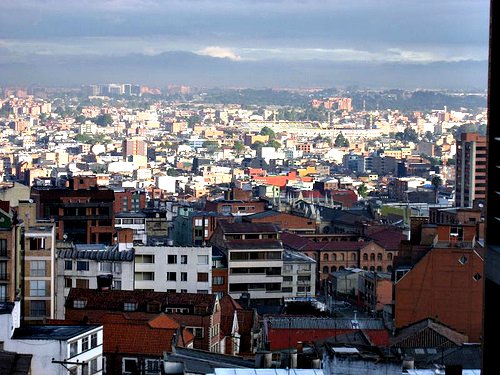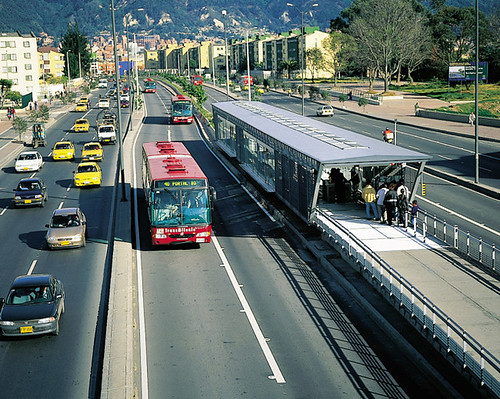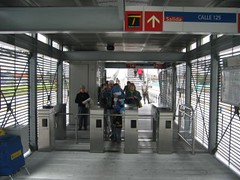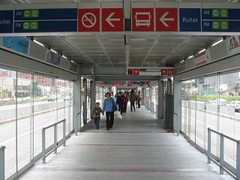Constructing a city around the concept of happiness

Posted March 5, 2010 at 1:30PM
“With our limited resources, we have to invent other ways to measure success. This might mean that all kids have access to sports facilities, libraries, parks, schools, nurseries.” These are the words of Enrique Peñalosa, who served as mayor of Bogotá, Colombia, for three years, and who has become an evangelist for improving the quality of life for city dwellers everywhere.
Jay Walljasper profiles Penalosa in Shareable, “a nonprofit online magazine that tells the story of sharing. We cover the people, places, and projects that are bringing a shareable world to life. And we share tools and tips to help you make a shareable world real in your life.” Walljasper writes that, under Penalosa’s leadership during three years as mayor, the city of 7 million accomplished the following:
- Created the TransMilenio, a bus rapid transit system (BRT) that carries a half million passengers daily in dedicated bus lanes.
- Built 52 new schools and refurbished 150 others while increasing student enrollment by 34 percent.
- Established or improved 1200 parks and playgrounds.
- Built three central and 10 neighborhood libraries.
- Built 100 nurseries for children under five.
- Expanded city water service to reach all of Bogotá’s households.
 Bought land for development as affordable housing, parks, schools, and greenways.
Bought land for development as affordable housing, parks, schools, and greenways. - Established 180 miles of bikeways, the largest network in the developing world.
- Created a 10.5-mile pedestrian street, and a 28-mile greenway in a corridor that had been originally slated for an eight-lane highway.
- Inaugurated an annual car-free day, when all Bogota residents commute to work in some way other than a private automobile.
- Planted 100,000 trees.
Not bad.
David Burwell, who founded the Rails to Trails Conservancy and co-founded the Surface Transportation Policy Project in the US, refers to Penalosa as “one of the great public servants of our time. He views cities as being planned for a purpose—to create human well-being. He’s got a great sense of what a leader should do—to promote human happiness.”
Walljasper, himself clearly an admirer of Penalosa’s work, also gives credit to others in the mayor’s administration, as well as to his civic-minded predecessor (and, as it happens, successor) as mayor, Antanas Mockus. At the core of their many achievements is an understanding that, as a city with great poverty in the developing world, Bogota has a responsibility to provide an especially rich public realm for its citizens. American cities would do well to take note.
Perhaps the greatest of these accomplishments is the Colombian capital's world-class transit system:
“Peñalosa’s proudest achievement is TransMilenio, the bus rapid transit (BRT) system that enables buses to zoom on special lanes that make mass transit faster and more convenient than driving. There are now eight TransMilenio routes criss-crossing Bogotá. The BRT idea was pioneered in Curitiba, Brazil, in the 1970s but Bogotá’s success shows it can work in a larger city.
“Oscar Edmundo Diaz, senior program director for the Institute for Transportation and Development Policy (ITDP), who was Peñalosa’s chief mayoral aide, proudly notes that even wealthy people who own cars are now enthusiastic users of the BRT. ‘You don’t want to build a transit system just for the poor,’ he counsels. ‘Otherwise it will be stigmatized, and even poor people will look down on it. If everyone uses it, it will help the poor more.’”
Reading about Penalosa, I couldn’t help but recall The Architecture of Happiness, a book by one of my very favorite writers and thinkers, Alain de Botton. Here’s an on-point passage about the book from de Botton’s website:
“One of the great, but often unmentioned, causes of both happiness and misery is the quality of our environment: the kind of walls, chairs, buildings and streets we’re surrounded by.
“And yet a concern for architecture and design is too often described as frivolous, even self-indulgent. The Architecture of Happiness starts from the idea that where we are heavily influences who we can be - and argues that it is architecture’s task to stand as an eloquent reminder of our full potential.
“Whereas many architects are wary of openly discussing the word beauty, the book has at its centre the large and naïve question: ‘What is a beautiful building?’ It amounts to a tour through the philosophy and psychology of architecture, which aims to change the way we think about our homes, streets and ourselves.”
Penalosa’s chief concern, of course, has not been architecture per se, but rather the setting and infrastructure that supports it, and thereby supports our lives and well-being. But the same principles apply, and I bet the two of them would make fascinating conversants over a dinner of bandeja paisa.
Here's a neat video from the ever-terrific Streetfilms that puts Bogota's civic achievements into context. It was filmed on location:
Read Walljasper’s article on Penalosa here.



